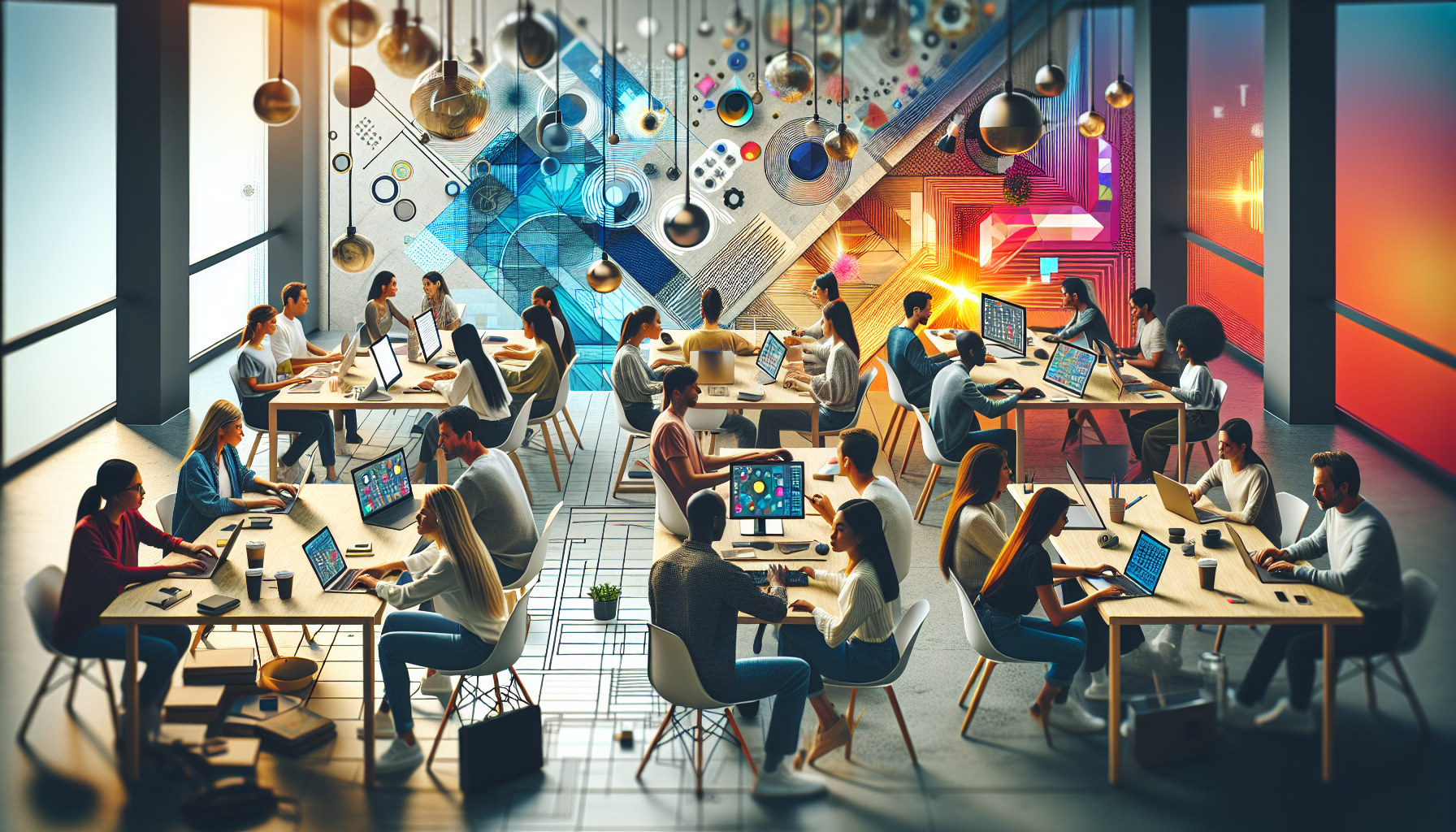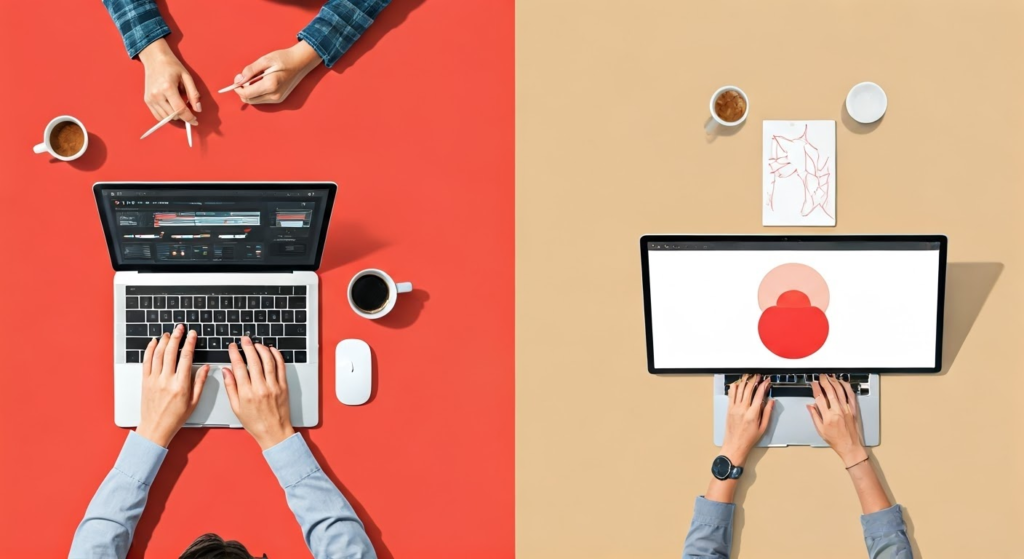High-quality design is often seen as costly and out of reach. But AI is changing that.
Artificial Intelligence (AI) is transforming the design industry by making high-quality design accessible and affordable for everyone. Gone are the days when only large companies could afford top-notch designs. With AI, small businesses and individuals can now create professional-looking designs without breaking the bank.
This technology uses advanced algorithms to automate many design tasks, saving time and reducing costs. From graphic design to visual arts, AI tools are revolutionizing the way we create and interact with design.
In this blog post, we’ll explore how AI is making high-quality design affordable for all, the benefits of using AI in design, and what the future holds for this exciting technology. Dive in to discover how AI is leveling the playing field in the world of design.

Credit: www.fiverr.com
The Role Of Ai In Transforming The Design Industry
AI is transforming the design industry by making high-quality design affordable for everyone. Advanced algorithms allow designers to create stunning visuals quickly and cost-effectively. This technology ensures accessible, professional designs for individuals and small businesses alike.
Artificial Intelligence (AI) is reshaping various industries. The design industry is no exception. AI is making high-quality design accessible for all. This shift is a game-changer for businesses and individuals alike.
Enhanced Design Tools
AI-powered tools are now available to everyone. These tools simplify the design process:
- Automated layouts: AI generates appealing layouts quickly.
- Color palettes: AI suggests color combinations that work well.
- Image editing: AI enhances images with minimal effort.
- Font pairing: AI recommends fonts that complement each other.
Cost Efficiency
AI reduces the cost of design services. This is good news for small businesses and freelancers:
- Less manpower: AI handles many tasks, reducing the need for large teams.
- Lower fees: AI tools are often more affordable than hiring designers.
- Quick turnaround: AI speeds up the design process, saving time and money.
Personalization
AI enables personalized design experiences. This means more tailored and relevant designs:
- User preferences: AI learns user likes and dislikes.
- Custom suggestions: AI offers design choices based on past behavior.
- Adaptive designs: AI adjusts designs to fit different platforms.
Democratization Of Design
AI makes design tools accessible to non-designers. This levels the playing field:
- User-friendly interfaces: AI tools are easy to use.
- No expertise needed: Anyone can create professional designs.
- Wide availability: AI design tools are available online.
Continuous Learning
AI continuously improves its design capabilities. This leads to better outcomes over time:
- Data analysis: AI learns from a vast amount of design data.
- Feedback loops: AI gets smarter with user feedback.
- Trend adaptation: AI keeps up with the latest design trends.
AI is transforming the design industry. It offers enhanced tools, cost efficiency, personalization, and accessibility. This makes high-quality design affordable for everyone.
The Benefits Of Using Ai For Affordable High-quality Designs
AI makes high-quality design accessible to everyone. It reduces costs and speeds up the design process. This allows more people to afford professional-looking graphics.
Artificial Intelligence (AI) is transforming how we approach design. It is not only making the design process more efficient but also more affordable. Let’s explore the specific benefits of using AI for affordable high-quality designs.
Cost-effective Solutions
AI offers significant cost savings in design. Here are a few ways it helps:
- Automated processes: Reduces the need for manual effort, cutting labor costs.
- Template libraries: Provides access to pre-designed templates, saving time and money.
- Faster turnaround: Completes tasks quickly, reducing project duration and expenses.
Enhanced Creativity
AI tools enhance creativity by providing unique ideas. Here’s how:
- Suggests variations: Offers multiple design options, sparking new ideas.
- Analyzes trends: Identifies current trends, ensuring designs are modern.
- Customization features: Allows easy adjustments, making each design unique.
Improved Efficiency
Efficiency in design is crucial. AI significantly boosts this aspect.
AI tools streamline workflows, reducing the time needed for tasks. They automate repetitive tasks, allowing designers to focus on creative work. With AI, the overall process becomes faster and more efficient.
User-friendly Interfaces
AI design tools are easy to use, even for beginners. Here’s why:
- Intuitive design: Simple and straightforward, requiring minimal training.
- Guided steps: Provides clear instructions, making the process easy.
- Support features: Offers help and tutorials, ensuring users are never stuck.
Consistency In Quality
Maintaining quality is essential in design. AI ensures high standards.
AI tools consistently produce high-quality designs. They follow set guidelines, ensuring each design meets specific standards. This consistency helps maintain a professional look across all projects.
Accessibility For Everyone
AI design tools are accessible to all, regardless of skill level. Here’s how:
- Affordable pricing: Makes high-quality design tools available to a wider audience.
- No expertise required: Allows anyone to create professional designs.
- Wide reach: Available online, making them accessible from anywhere.
Personalization Options
Personalization is key to unique designs. AI excels in this area.
AI tools offer extensive customization options. Users can easily tweak templates to fit their needs. This flexibility ensures that each design is tailored to specific preferences, making it unique and personal.
Data-driven Insights
Data insights play a crucial role in design decisions. AI provides valuable data.
AI tools analyze user behavior and preferences. They offer insights that guide design choices. This data-driven approach ensures designs are effective and resonate with the target audience.
Scalability
Scalability is important for growing businesses. AI supports this need effectively.
AI tools can handle multiple projects simultaneously. They scale up to meet increasing demands. This capability ensures that businesses can grow without compromising on design quality or efficiency.
Quick Adaptation To Trends
Staying updated with trends is vital. AI keeps designs current.
AI tools monitor design trends in real-time. They adapt quickly, ensuring designs are always up-to-date. This quick adaptation helps keep the brand relevant in a rapidly changing market.
Ai Tools Revolutionizing Graphic Design And Visual Arts
AI tools are making high-quality design affordable. They help create stunning visuals quickly. This technology saves time and reduces costs, benefiting everyone.
The landscape of graphic design and visual arts is changing. AI tools are making high-quality design more accessible to everyone.
Automated Design Platforms
Automated design platforms are a game changer. They offer users the tools to create professional designs without any prior experience.
- Canva: A user-friendly interface that simplifies graphic design.
- Crello: Offers various templates for different design needs.
- Snappa: Ideal for creating social media graphics quickly.
Intelligent Image Editing
AI-powered image editors enhance photos and graphics with precision. These tools save time and produce high-quality results.
- Adobe Photoshop Elements: Uses AI to automate complex edits.
- Luminar: AI enhances photo quality with one-click fixes.
- Fotor: Offers AI retouching for flawless images.
Ai-powered Logo Makers
Creating a logo is now easier than ever. AI tools generate unique designs based on user inputs.
- Looka: Customizes logos with AI based on industry and style.
- LogoMakr: Generates various logo options quickly.
- Tailor Brands: Provides AI-generated logo designs tailored to your brand.
Content-aware Layouts
AI helps in creating layouts that adapt to content. This ensures a cohesive and visually appealing design.
- Adobe Spark: Automatically adjusts layout to fit content.
- DesignScape: Offers content-aware design adjustments.
- RelayThat: Optimizes layouts for different platforms.
Ai-driven Color Palettes
Choosing the right color scheme is crucial. AI tools suggest color palettes that enhance the design’s visual impact.
- Coolors: Generates color palettes that match your design.
- Colormind: Uses AI to create harmonious color combinations.
- Khroma: Personalizes color palette suggestions based on user preferences.
With these AI tools, high-quality design is within reach for everyone. The future of graphic design and visual arts is bright, thanks to AI advancements.

The Impact Of Ai On Small Businesses And Independent Designers
AI helps small businesses and independent designers create high-quality designs at lower costs. Advanced tools simplify the process, making professional design accessible to everyone.
AI is transforming the world of design. It’s making high-quality design affordable for everyone. Small businesses and independent designers are reaping the benefits. Let’s explore how AI is impacting them.
Cost Reduction For Small Businesses
AI tools help small businesses save on design costs. Here are some ways this happens:
- Automated design processes: AI can handle routine design tasks. This reduces the need for human designers.
- Affordable design tools: Many AI design tools are cost-effective. They fit within small business budgets.
- Reduced time investment: AI speeds up the design process. Businesses get designs faster and spend less on revisions.
Increased Accessibility To Professional Design
AI is bridging the gap between small businesses and professional design quality. Here’s how:
- User-friendly interfaces: AI tools are easy to use. No design expertise is needed.
- High-quality templates: These tools offer professional templates. Small businesses can create polished designs.
- Customization options: AI allows for easy customization. Businesses can personalize designs to fit their brand.
Empowerment Of Independent Designers
Independent designers are also benefiting from AI. These tools enhance their creativity and productivity.
Independent designers gain a competitive edge with AI. Here’s why:
- Enhanced creativity: AI provides new design ideas. Designers can experiment with innovative concepts.
- Increased productivity: AI handles repetitive tasks. Designers focus more on creative work.
- Access to advanced tools: AI offers tools once available to large firms. Independent designers now have these at their fingertips.
Simplified Collaboration And Feedback
AI simplifies design collaboration. Teams and clients can work together more efficiently.
Collaboration and feedback processes are smoother with AI. Here’s how:
- Real-time edits: AI tools allow instant changes. Teams can see updates immediately.
- Easy sharing: Designs can be shared online. This makes feedback quick and efficient.
- Version control: AI tracks changes. This ensures everyone works on the latest design version.
Enhanced Design Quality
AI enhances the overall quality of designs. Even those without design skills can produce impressive work.
AI tools ensure high design quality. Here’s why:
- Intelligent suggestions: AI offers smart design suggestions. This improves the final product.
- Error reduction: AI minimizes design errors. This leads to cleaner, more professional designs.
- Consistency: AI maintains design consistency. Brands can ensure their visuals are uniform.
These points show how AI is making high-quality design accessible. It’s not just for big companies anymore. Small businesses and independent designers can now afford top-notch designs.
Challenges And Considerations When Implementing Ai In Design Projects
AI tools are making high-quality design accessible for everyone. They reduce costs and streamline processes, offering affordable options. Yet, challenges like data privacy and creative control remain significant considerations.
AI is transforming the design world. It’s making high-quality design more accessible and cost-effective. Yet, implementing AI in design projects comes with its own set of challenges and considerations.
Data Privacy And Security
Ensuring data privacy and security is crucial when using AI in design.
- Sensitive information: AI systems often handle personal and confidential data.
- Data breaches: There’s a risk of unauthorized access to this data.
- Legal compliance: Designers must adhere to data protection laws and regulations.
Integration With Existing Tools
Incorporating AI into current design workflows can be tricky.
- Compatibility: Ensuring AI tools work well with existing software.
- Learning curve: Teams need time to adapt to new technologies.
- Workflow disruption: Integrating AI may temporarily slow down projects.
Cost Of Implementation
Budget constraints can affect the adoption of AI in design.
- Initial investment: High upfront costs for AI tools and training.
- Ongoing maintenance: Continuous updates and support can add to expenses.
- ROI uncertainty: Unclear if the investment will pay off in the long run.
Quality Control
Maintaining high design standards is essential when using AI.
- Human oversight: Designers need to review AI-generated content.
- Consistency: Ensuring AI outputs meet brand guidelines.
- Error detection: Identifying and correcting mistakes made by AI.
Ethical Considerations
Ethical issues can arise with AI in design.
- Bias: AI systems can reflect existing prejudices in data.
- Transparency: Users should understand how AI makes decisions.
- Accountability: Determining who is responsible for AI’s actions.
Skill Development
Designers must upskill to work effectively with AI.
- Training: Learning to use new AI tools and software.
- Adaptability: Staying updated with the latest AI advancements.
- Collaboration: Working alongside AI to enhance creativity.
Reliability And Performance
AI tools need to be reliable and perform well.
- Downtime: AI systems can experience outages or malfunctions.
- Scalability: Ensuring AI solutions can handle large-scale projects.
- Speed: AI should improve efficiency without sacrificing quality.
User Experience
AI should enhance, not hinder, user experience in design projects.
- Intuitiveness: AI tools must be easy to use and navigate.
- User feedback: Incorporating feedback to improve AI interfaces.
- Accessibility: Ensuring AI-generated designs are user-friendly for everyone.
The Future Outlook: How Will Continued Advancements Impact Accessibility?
AI advancements are making high-quality design more affordable. This technology allows everyone to access professional design tools easily. These tools simplify the design process, making it more user-friendly and cost-effective.
Artificial intelligence is transforming the design industry. It’s making high-quality design accessible to everyone. With AI, stunning designs are no longer limited to big budgets. Let’s explore how future advancements will continue to impact accessibility.
Enhanced Customization Options
As AI evolves, design customization will improve. This means more tailored designs for users.
- Personalized templates: AI will create templates suited to individual needs.
- Adaptive design elements: Elements will adjust based on user preferences.
- User-specific recommendations: AI will suggest designs based on past choices.
Cost Reduction And Efficiency
AI-driven tools are reducing costs and increasing efficiency. This benefits both designers and clients.
- Automated tasks: Routine tasks can be handled by AI, saving time.
- Reduced labor costs: Less manual work means lower expenses.
- Faster project turnaround: Projects can be completed more quickly with AI.
Broader Accessibility To Professional Tools
AI is making professional design tools available to everyone. Advanced features are now within reach.
Many AI tools are affordable or even free. This opens up opportunities for more people. These tools offer intuitive interfaces, making design simple for non-experts.
Continuous Learning And Improvement
AI systems learn and improve over time. This means they get better at design tasks.
- Data-driven insights: AI analyzes data to enhance its capabilities.
- User feedback integration: AI tools evolve based on user input.
- Predictive modeling: Future trends can be anticipated and incorporated.
Inclusion And Diversity In Design
AI can promote inclusive and diverse design. It ensures designs cater to a wider audience.
Design elements can be tailored to different cultures and preferences. AI considers various factors to create more inclusive designs. This helps in reaching a broader and more diverse audience.
Embrace The Change – Making High-quality Designs Accessible To All With Ai Innovation
AI innovations make high-quality design affordable for everyone. These advancements reduce costs and simplify complex design processes. Access to professional designs is now within reach for all.
Artificial intelligence is transforming the design world. High-quality designs are now within everyone’s reach. AI tools simplify complex tasks, making professional designs accessible to all. Small businesses and individuals can now create stunning visuals without breaking the bank.
Automated Design Creation
AI can generate designs automatically. This saves time and effort:
- Templates: AI offers a variety of pre-designed templates.
- Customization: Users can easily modify designs to fit their needs.
- Speed: AI creates designs much faster than humans.
- Consistency: Ensures uniformity across all design elements.
Cost-effective Solutions
AI reduces the cost of high-quality designs. This benefits everyone:
- Affordable Tools: Many AI design tools are free or low-cost.
- Reduced Need for Experts: No need to hire expensive designers.
- Scalable Solutions: Suitable for both small and large projects.
- Accessibility: Even non-designers can create professional designs.
User-friendly Interfaces
Modern AI design tools are easy to use. No prior experience required:
- Drag-and-Drop: Simple drag-and-drop features for easy design creation.
- Tutorials: In-app tutorials guide users through the process.
- Intuitive Controls: User-friendly controls make design accessible.
- Community Support: Access to a wide range of user communities for help.
Personalized Design Recommendations
AI can suggest design ideas based on user preferences. This enhances creativity:
- Style Suggestions: AI recommends styles based on user history.
- Color Palettes: Suggests complementary color schemes.
- Layout Options: Offers various layout choices for different needs.
- Font Pairings: Recommends fonts that work well together.
Embrace AI and make high-quality designs accessible to all. The future of design is here.

Credit: creators.spotify.com
Frequently Asked Questions
What Role Does Ai Play In Design?
AI automates repetitive tasks, offers creative suggestions, and improves design efficiency. It helps designers focus on creativity.
How Does Ai Make High-quality Design Affordable?
AI reduces design costs by automating processes, reducing the need for extensive manual work, and speeding up production.
What Ai Tools Are Popular In Graphic Design?
Popular AI tools include Adobe Sensei, Canva, and Designhill. These tools enhance creativity and streamline design processes.
How Can Small Businesses Benefit From Ai Design Tools?
Small businesses gain access to professional-quality designs at a fraction of the cost, enhancing their brand image affordably.
Conclusion
AI is transforming design by making high-quality work affordable for everyone. Small businesses and independent designers benefit greatly. New AI tools simplify graphic design tasks. They also save time and reduce costs. As AI advances, accessibility in design will improve further.
Embrace AI to stay competitive and creative. High-quality design is no longer a luxury. It’s now within reach for all, thanks to AI.
